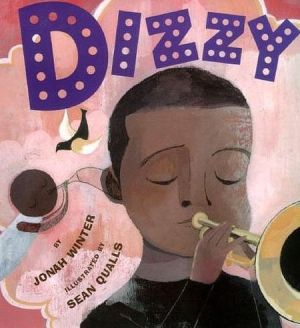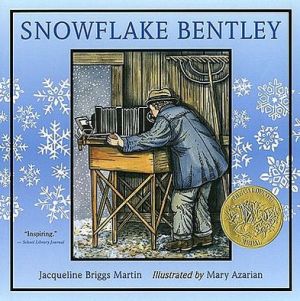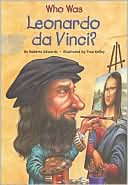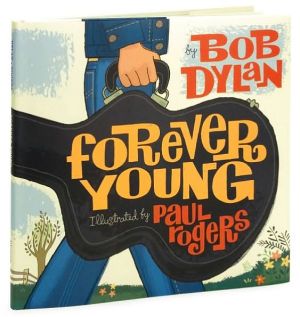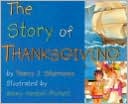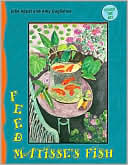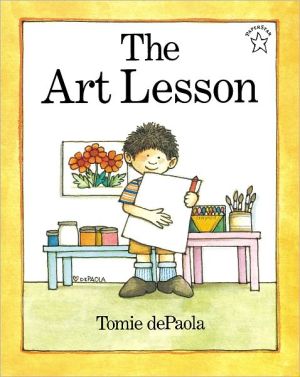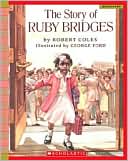Dizzy
From the author of FRIDA comes a jangly, jumpy, beboping book about Dizzy Gillespie, the clown prince of jazz.\ This is the story of Dizzy Gillespie, a real cool cat who must have been born with a horn in his hands, judging from the way he played the trumpet. Jazz was his ticket on a train to better days, and he left his hard life in a small town for New York City and the hottest band around. But did Dizzy stand straight and play right? NO! He was a clown. He hit high notes, low notes,...
Search in google:
This is the story of Dizzy Gillespie, a real cool cat who must have been born with a horn in his hands, judging from the way he played the trumpet. Jazz was his ticket on a train to better days, and he left his hard life in a small town for New York City and the hottest band around. But did Dizzy stand straight and play right? NO! He was a clown. He hit high notes, low notes, never-been-heard notes, and before he knew it, Dizzy created a whole new music: BEBOP. This is a story about a boy who breaks all the rules -- and finds his own personal heaven along the way.Child MagazineFor Dizzy Gillespie, the great jazz trumpeter, "the very thing that had gotten him into trouble so much-being a clown, breaking all the rules-had become the thing that made him great." Teeming with originality and style, Qualls's creamy paint, pencil and collage illustrations convey the dogged individualism of the creator of bebop. Fine storytelling makes Gillespie's life not just approachable, but inspirational to children, as they watch him evolve from a poor, small, beaten child into a strong-minded man who, despite naysayers, pushed American music in a completely new direction. (Ages 6 to 8)Child magazine's Best Children's Book Awards 2006
\ From the PublisherKikrus Starred The syncopated rhythms of bebop form the backbeat to this introduction to Dizzy Gillespie.\ Winter sets his stage with a firm delineation of young Gillespie's character: A little boy who was the target of bullies and the victim of an abusive father found an outlet with the trumpet, and turned himself into a clown. The narrative focuses on Gillespie's own emotional and artistic journey,\ celebrating his desire to take risks “until the very thing that had gotten him into trouble / so much /\ being a clown, breaking all the rules / had become the thing that made him great, / . . . . ” The text breaks into ecstatic scat while the illustrations move from representational art to abstract depictions of the jagged sounds of jazz. Qualls's acrylic-and-collage images employ a muted palette of pinks and blues and beiges, and compositions vary from scenes of daily life to poster-like montages, effectively establishing Gillespie as larger than life. The narrative culminates in a priceless image of Dizzy\ “shov[ing] the angel Gabriel out of the way / and show[ing] him how to play / Bebop.” “OOP BOP SH'BAM!” (author's note) (Picture book/biography. 5-10)\ Boolist*STAR*\ There have been many books about jazz for young readers, a peculiar topic because, as a rule, it's not a form of music that children have an affinity for, if they are familiar with it at all. But, together, Winter and Qualls make it work. That's because Winter recognizes that if he can get readers interested in a character-in this case, trumpet revolutionary Dizzy Gillespie-they will want to learn more about his music. And Qualls is able to translate the story (and the music) into shapes and colors that undulate and stream across the pages with a beat and bounce of their own. The story of "one real cool cat" begins with a South Carolina childhood full of blue notes. Poor, abused, and angry, young John Birks Gillespie has his life turned around after a teacher gives him a trumpet. In a two-page spread, a river of red--his anger in living color--bursts out of Gillespie's new horn as he blows "REALLY LOUD." An explanation of jazz follows, and it is simple enough for the audience: "You took a melody and played it all different ways . . . changed every phrase-it was crazy." That is followed up with a bit more illumination dear to kids' hearts: "If a melody was like a rule, jazz was like breaking the rules, like inventing new rules. Jazz was like getting into trouble." Tracing Gillespie's ascent in the New York jazz world of the early 1940s, the story catches the excitement of the city, meshing it with the trumpeter's crazy personality (which earned him the nickname Dizzy); meanwhile, the artwork zigs and zags in color combinations that evoke the nightclub scene-greens, tans, a bit of peach, all counterpointed with muted grays. An author's note fills out Dizzy's story and lauds him for a personal life that was as composed as his music was wild. Turn up the stereo: kids will want to hear it for themselves. -Ilene Cooper HB Young John (later Dizzy) Gillespie was a cutup and attention seeker who was fired from several bands because of his lack of seriousness. But his sense of play and hot-dog musicianship allowed him to become one of the innovators of be-bop as well as a great jazz trumpeter and singer. Winters (author of Frida, rev. 3/02) uses rhyme, repeated text, and unexpected line breaks to reflect Dizzy's musical style. Most of the time this works well, encouraging readers-aloud to perform the text with a jazzy rhythm and to emphasize the occasional large, bold-type word like one of Dizzy's sudden high blats. The text does include a few passages that slow the pace or use disappointingly predictable rhyme ("So he boarded a train and moved up north / to a place they call Philly. / Right off the bat, / he got a job in a jazz band / and\ \ \ \ \ \ From The CriticsFor Dizzy Gillespie, the great jazz trumpeter, "the very thing that had gotten him into trouble so much-being a clown, breaking all the rules-had become the thing that made him great." Teeming with originality and style, Qualls's creamy paint, pencil and collage illustrations convey the dogged individualism of the creator of bebop. Fine storytelling makes Gillespie's life not just approachable, but inspirational to children, as they watch him evolve from a poor, small, beaten child into a strong-minded man who, despite naysayers, pushed American music in a completely new direction. (Ages 6 to 8)\ Child magazine's Best Children's Book Awards 2006\ \ \ Publishers WeeklyWinter (Frida) adds a winning volume to the burgeoning array of picture books about jazz giants. Written in up-tempo, occasionally rhyming free verse, the narrative trips off the tongue as it sketches Dizzy Gillespie's early sufferings: his father beat him and other kids mocked his small size. The horn became his escape valve: "with every blow/ he got from his dad,/ he blew his trumpet that much more/ until he was roaring./ He was soaring./ He was the best musician/ in his little southern town-/ soon that got boring." Winter follows Dizzy from Philadelphia (where his onstage clowning earned him his nickname) to New York, where his career took off. Readers need not know anything about the man's music to appreciate the character at the center of this verse, which nimbly sketches his rise from swing band sideman to one of cool jazz's supreme innovators: " `Bebop.'/ That's what Dizzy called/ this crazy kind of jazz/ that he had invented just/ by having the courage to be himself." Qualls's (The Baby on the Way) expressionistic acrylics, in a palette of cool grays, blues and chalk white, bloom with the blaring hot red and pink streams of sound emanating from Dizzy's horn. The artist gets the cheeks and the jazz patch just right, along with the postures of various cats onstage. And the author plays softly on the theme that one can convert a flaw (as a boy, Dizzy was famous for breaking rules) into a strength. Ages 4-8. (Oct.) Copyright 2006 Reed Business Information.\ \ \ \ \ Children's LiteratureTold in a loose, rap style with occasional rhyme, the life of Gillespie, "one real cool cat," is traced from his poor childhood, when he was beaten by his dad and had to fight bullies to survive. When his music teacher gives him a trumpet, blowing it feels GOOD! Instead of fighting, he plays until he is "the best musician in town." He wants to play the new kind of music called "jazz;" it broke the rules and was fun to play. Kidding around with his playing in Philadelphia earns him the nickname of "Dizzy." He goes from there to New York, a place that he feels breaks the rules the way he does. Although in trouble at first, he hits his stride there, finally on top of the world, playing his "Bebop" on his way into Jazz Heaven. The visuals and page designs here swing along with the written story; there is even some playing around with the type face here and there to emphasize a point, for words like "COOOOOOOOL" or "CRAZY" or "DIZZY." Told on double pages with background bits of varying colors, the visual story has superimposed people playing instruments, dancing, or listening. Often color streams out of horns like sounds. The large pages with images composed of acrylic, collage, and pencil seem to pulse with the evolving music. An "Author's Note" fills in more of the facts than the jazzy text can include. 2006, Arthur A. Levine Books/ Scholastic, Ages 4 to 8. \ —Ken Marantz and Sylvia Marantz\ \ \ \ \ School Library JournalGr 3-8-Through a powerful marriage of rhythmic text and hip and surprising illustrations, the unorthodox creator of Bebop comes to life. Beaten regularly by his father, the young Gillespie found escape in a trumpet given to him by his music teacher. "For the boy with the horn/fueled with a FIRE/that burned with every whooping,/JAZZ was like a fire extinguisher./It was cooooooool." He went on to become a crowd-pleasing performer, loving jazz because it "...was like breaking the rules,/like inventing new rules." Later, in New York, he began playing his own music. He called it Bebop: "It was like he had taken a wrecking ball/and SMASHED IN/The House of Jazz,/till the walls came tumbling down-." Winter's lively writing pops with energy and begs to be read aloud. Qualls's acrylic, collage, and pencil illustrations swing across the large pages with unique, jazzy rhythms, varying type sizes and colors, and playful perspectives, perfectly complementing the text. This is a book that has a message: "-the very thing that had gotten him into trouble/so much-/being a clown, breaking all the rules-/had become the thing that made him great-." But most important, it is a delightful story that introduces readers to an influential and unique American musician.-Lee Bock, Glenbrook Elementary School, Pulaski, WI Copyright 2006 Reed Business Information.\ \ \ \ \ Kirkus ReviewsThe syncopated rhythms of bebop form the backbeat to this introduction to Dizzy Gillespie. Winter sets his stage with a firm delineation of young Gillespie's character: A little boy who was the target of bullies and the victim of an abusive father found an outlet with the trumpet, and turned himself into a clown. The narrative focuses on Gillespie's own emotional and artistic journey, celebrating his desire to take risks "until the very thing that had gotten him into trouble / so much- / being a clown, breaking all the rules- / had become the thing that made him great, / . . . . " The text breaks into ecstatic scat while the illustrations move from representational art to abstract depictions of the jagged sounds of jazz. Qualls's acrylic-and-collage images employ a muted palette of pinks and blues and beiges, and compositions vary from scenes of daily life to poster-like montages, effectively establishing Gillespie as larger than life. The narrative culminates in a priceless image of Dizzy "shov[ing] the angel Gabriel out of the way / and show[ing] him how to play / Bebop." "OOP BOP SH'BAM!" (author's note) (Picture book/biography. 5-10)\ \
